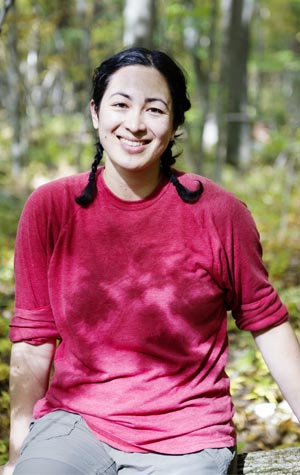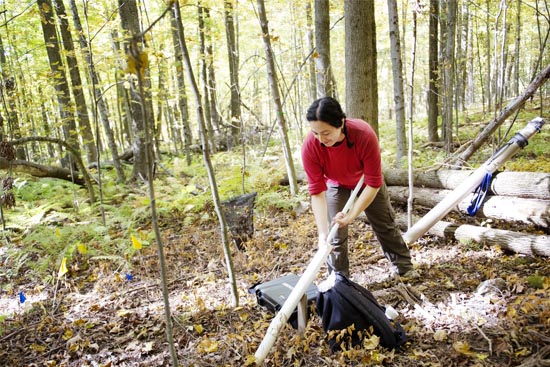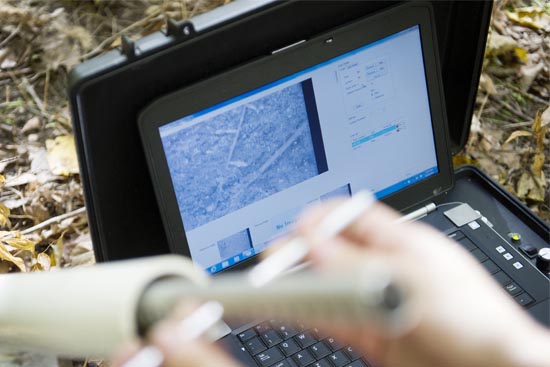Tracing Our Roots
GRS student digs deep into the carbon cycle

Rose Abramoff believes that to learn more about the air we breathe, we must venture underground. Once a month, she hikes into 3,500 acres of protected forest in Central Massachusetts, brushing away fallen branches and leaves and digging through rich soil to uncover her subject of interest: plant roots.
Abramoff (GRS’15), a biology doctoral student, is studying the relationship between climate change and the life cycle of plants. She focuses on carbon production, accumulation, and respiration in plant roots and how these factors vary seasonally and between species. She hopes her work will provide insight into solutions to global warming.
“We have a pretty serious emissions problem that has already caused warming by 1.3 to 1.9 degrees Celsius in the United States since 1895,” says Abramoff, citing National Climate Assessment data. “Roots and soil microbes are sensitive to climate change, and we need to understand how they will respond in order to make useful predictions that can inform policy.”
Evaluating the role of roots in the underground carbon cycle is a new science—most studies focus on leaves during photosynthesis, Abramoff explains. But leaves die and decompose quickly. Roots, on the other hand, may be able to store carbon for a prolonged period of time, even during the winter.
“People have been interested in roots for a long time,” she says, “but we are now developing the tools that allow us to make these measurements.”
Abramoff’s research, which is funded by the US Department of Energy, was recognized last summer when she was awarded a $20,000 dissertation fellowship from the American Association of University Women (AAUW). The funding will cover living expenses as she concentrates on writing her dissertation and publishing results.
“Rose is making a contribution, increasing scientific understanding and engaging the public,” says Gloria Blackwell, AAUW vice president of fellowships, grants, and global programs. “Her project was something previously ignored, but very important.”
Plants require carbon dioxide and nitrogen to grow, the same gases whose increasing presence in the atmosphere has been linked to climate change. Forests have the potential to serve as carbon “sinks,” storing the carbon compounds in their roots and leaves, an alternative destination for gases that would otherwise linger in the atmosphere.

However, a plant must also accommodate the carbon released by microbes and fungi as its own leaves and roots decompose. Typically, the amount of carbon lost from a single tree through decomposition is more than compensated for by what it takes in for its own growth, says Abramoff’s faculty advisor, Adrien Finzi, a College of Arts & Sciences professor of biology. But not all forests can store the additional carbon released by fossil fuels. Abramoff is studying how certain species of trees use the carbon they’ve taken in and how this changes seasonally.
She conducts her experiments at Harvard Forest in Petersham, which is an ideal location, in part because of access to archived data from affiliate universities. Abramoff, accompanied by Mustafa Saifuddin (GRS’20) and several undergraduate assistants, stakes out plots of red oak, eastern hemlock, and white ash, the three most dominant species in the forest.
Her research begins with a soil sample measurement at each site. She collects a portion of roots from each of the sample trees by probing inches into the ground with a spade and taking soil cores, a tedious process she admits she “lets the undergrads do.” Once the samples are gathered, she tenderly picks the root fragments from the pile of soil, washing and weighing them to determine overall biomass. After they dry, Abramoff places the roots in an infrared gas analyzer, known affectionately to botanists as IRGA, a device that uses specific wavelengths to identify the presence of trace gases. With this technology, she can calculate the approximate amount of carbon dioxide released by the roots during the respiration and decomposition processes.
But to really understand roots and carbon uptake during their development and turnover, Abramoff must do more than dig. She needs to watch what happens where they live—underground—a task that requires the latest technology: a mini-rhizotron camera, developed in the 1980s. Buried among the roots in a six-foot-long transparent plastic tube, the camera is capable of snapping 20,000 images per day to create a downloadable time-lapse video of root growth. From the comfort of the lab, Abramoff can then analyze the compiled videos to determine rates of growth and spatial distribution.
She creates mathematical and computer simulation models to interpret her data, but has few studies with which to compare her results. For Abramoff, pioneering this research is precisely what attracted her to the field.

“I want to study plant processes that are poorly understood,” she says. “Researchers often suggest that we need more information about root dynamics, but studies on this topic are few because root work is often perceived as difficult. I think this perception is false. It’s easier to do research aboveground”—atmospheric carbon level data have been available since the 1950s, she says—“but you might miss something.”
She believes previous studies did, in fact, miss something. Abramoff has noted key differences among red oak, eastern hemlock, and white ash, with deciduous (leaf-shedding) trees demonstrating earlier root growth than their evergreen counterparts. Scientists previously based their climate research on the belief that all trees follow the same seasonal cycle of growth. Abramoff hopes to use her findings to more accurately show how one particular type of tree might allocate its carbon use differently from others within the same forest.
“Rose is rapidly becoming an expert in linking data with models,” says Finzi. “Advancements in computer processing power, statistical analyses, and data-assimilation will transform the field in which we work. I suspect Rose will play a big part in that transformation.”
Abramoff’s data have also uncovered a previously undocumented correlation between temperature and offsets between root and shoot development, showing that in some biomes plant organs commonly grow out of sync. Roots, unlike leaves or shoots, can grow at many different times during the year. This finding is critical, she says, because it invalidates the assumption made in previous carbon models that growth patterns are simultaneous throughout the plant. If roots continue to grow in the winter, they could be using more carbon than we think, she explains. A better understanding of seasonal and species variation is important in determining which forests can serve as carbon “sinks” and can assist in environmental conservation and management of these areas.
Abramoff and Finzi published her results in November in the journal New Phytologist. Ultimately, Abramoff hopes her work will extend beyond the scientific community. “My advisor and I want to help humanity and urban and natural systems,” she says. “It’s less about science and more about our consequences to nature: how we change and define it.”
Learn more about Abramoff’s project here or follow her on Twitter at @ultracricket.
A version of this article was originally published in Bostonia.
Ashley Jones can be reached at ashjones@bu.edu.
Comments & Discussion
Boston University moderates comments to facilitate an informed, substantive, civil conversation. Abusive, profane, self-promotional, misleading, incoherent or off-topic comments will be rejected. Moderators are staffed during regular business hours (EST) and can only accept comments written in English. Statistics or facts must include a citation or a link to the citation.